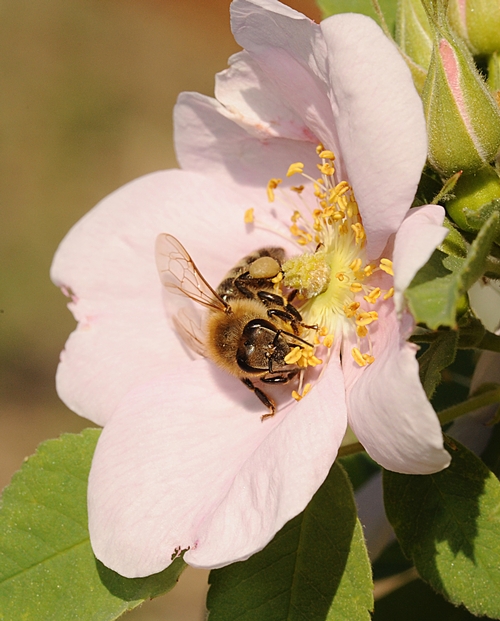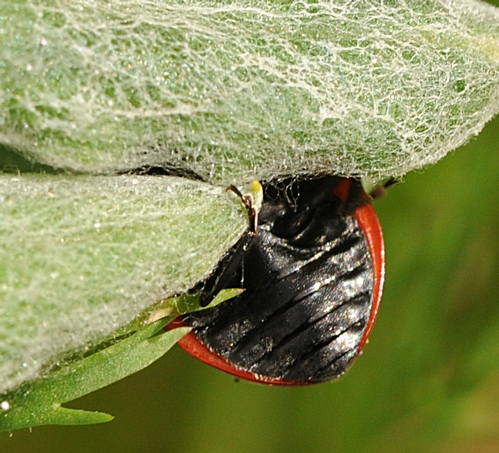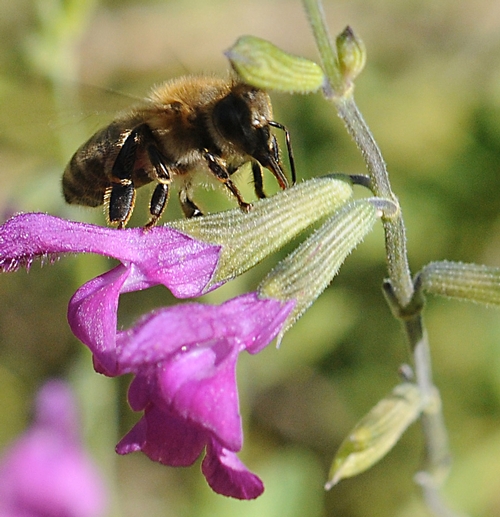- Author: Kathy Keatley Garvey
The wild roses planted last fall in the Häagen-Dazs Honey Bee Haven at the Harry H. Laidlaw Jr. Honey Bee Research Facility, University of California, Davis, are both "heaven sent" and "heaven scent."
The fragrance is delightful.
Basically, only wild roses--not the commercially grown roses found in our gardens--attract bees, according to Eric Mussen, Extension apiculturist with the UC Davis Department of Entomology.
Also in bloom in the half-acre garden, located on Bee Biology Road on the west end of the campus, are salvia (sage), lavender, artichokes, seaside daisies, Mexican hat flowers and purple coneflowers, among others.
The grand opening celebration, open to the public, is set for 10 a.m. to 2 p.m. on Saturday, Sept. 11. Folks planning to attend may RSVP to Nancy Dullum of the UC Davis Department of Entomology administrative team, at nadullum@ucdavis.edu. (Insert "haven" in the subject line and indicate how many in your party will attend.)


- Author: Kathy Keatley Garvey
Ladybugs, aka ladybird beetles, are searching for aphids and other soft-bodied insects.
If you see a ladybug (family Coccinellidae), odds are you'll see her prey, the plant-sucking aphids.
Today we spotted a ladybug in a flower garden on the UC Davis campus and she wasn't there to enjoy the warm sunshine or watch the students go by.
She was there to dine.
The ladybug snared a few aphids, then flipped under a leaf like an Olympic athlete performing a daily routine.
She wasn't going for a gold medal, though. She was heading for another kind of gold--a gold aphid.




- Author: Kathy Keatley Garvey
"R" is for research at the Harry H. Laidlaw Jr. Honey Bee Research Faciity at the University of California, Davis.
What's it all about?
The Laidlaw facility is a nexus for diverse bee research and scientists from throughout the world.
A poster hanging in the Laidlaw facility explains: "We provide cutting-edge research on basic bee biology, genetics, pollination and conservation. We address international concerns about bee health and meet the needs of California's multibillion dollar agriculture industry. Our program combines research on honey bees and native species to promote sustainabiity of pollinators and pollination."The researchers include:
Honey bee specialists: Extension apiculturist Eric Mussen; bee breeder-geneticist Susan Cobey and manager of the Laidlaw facility (she trained under Laidlaw); bee breeder-geneticist Kim Fondrk who manages the Robert Page Honey Bee Pollen Hoarding Selection Program; and Haagen-Dazs Honey Bee Postdoctural Fellow Michelle Flenniken. An insect virus researcher, Flenniken investigates the viruses and other microbes associated with honey bees using a molecular biology approach.
Native pollinator specialists: Robbin Thorp, emeritus professor; and Neal Williams, assistant professor. Thorp "officially" retired in 1994 but continues to conduct research on bees (Apoidea) with a focus on native bees, their ecology, systematics, biodiversity, conservation and pollination relationships. Williams says his lab "explores fundamental questions about the evolution and ecology of bees and pollination as well as applied research on crop pollination and native bee conservation within the context of global change and agricultural sustainability."
Visiting scientists:
Claire Kremen, a conservation biologist at UC Berkeley, is closely associated with UC Davis. Her Berkeley lab explores "the conservation and sustainable management of ecosystem services such as pollination and pest control in agricultural settings." Her group is involved with several research projects through the Laidlaw facility.
Other visiting scientists include Stephen Hendrix of the University of Iowa; Susan Monheit, UC Davis; Lora Morandin, UC Berkeley; and Alexandra Klein and Claire Brittain, both with the University of Goettingen, Gemany.
Another exciting research program at UC Davis involves the aging and lifespan of the honey bee. Robert Page, former professor and chair of the UC Davis Department of Entomology and now founding director of the School of Life Sciences at Arizona State University, is a co-principal investigator on this research. It's part of the federally funded Biodemographic Determinants of Lifespan, directed by UC Davis entomology professor James R. Carey.
Another highlight at the Laidlaw facility is the newly planted Häagen-Dazs Honey Bee Haven, a half-acre bee friendly garden designed to be a year-around food source for bees and an educational experience for visitors. Also new is the Campus Buzzway, a quarter-acre wildflower garden to be planted this fall."R" is for research. "B" is for bees.

- Author: Kathy Keatley Garvey
You've probably seen carpenter bees engage in the practice known as "nectar robbing."
Due to their large size, they cannot enter tubelike blossoms such as salvia (sage), so they slit the base of the corolla. They rob the nectar without pollinating the flower.
But have you ever seen a honey bee come along and enter the very spot of a corolla that a carpenter bee has pierced?
We saw a honey bee do just that at the UC Davis Arboretum last weekend.
Maybe this UC Davis bee was "smarter" than the average bee?

- Author: Kathy Keatley Garvey
Don't know if silence is GOLDEN, but Italian honey bees definitely are.
Early morning Saturday, I watched a bee the color of liquid gold nectaring the lavender in our yard.
A golden opportunity to capture her brilliance. She won't live long. Field bees live only four to six weeks in the peak season, so in a few weeks she'll be gone. Others will take her place.
A click of the shutter and a moment preserved in time.
Meanwhile, work is progressing on the Häagen-Dazs Honey Bee Haven, a half-acre bee friendly garden situated next to the Harry H. Laidlaw Jr. Honey Bee Research Facility, University of California, Davis.
By mid-October it will be finished and ready for golden moments--for the honey bees and the visitors. The haven will be a year-around food source for bees. Plus, it is expected to increase public awareness about the plight of bees AND help visitors glean ideas about what to plant in their own gardens.
Lavender is one of them.




